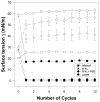A Combination of the Aerosolized PPAR-γ Agonist Pioglitazone and a Synthetic Surfactant Protein B Peptide Mimic Prevents Hyperoxia-Induced Neonatal Lung Injury in Rats
- PMID: 29428947
- PMCID: PMC5980711
- DOI: 10.1159/000486188
A Combination of the Aerosolized PPAR-γ Agonist Pioglitazone and a Synthetic Surfactant Protein B Peptide Mimic Prevents Hyperoxia-Induced Neonatal Lung Injury in Rats
Abstract
Background: Despite improvements in perinatal care, bronchopulmonary dysplasia (BPD) in extremely premature infants has not decreased. Postnatal surfactant therapy provides symptomatic relief from respiratory distress syndrome, but does not translate into a reduction in BPD. Therefore, the search for effective interventions to prevent BPD continues.
Objectives: Since PPAR-γ agonists have been demonstrated to promote neonatal lung maturation and injury repair, we hypothesized that a formulation of a PPAR-γ agonist, pioglitazone (PGZ) and a synthetic lung surfactant (a surfactant protein B peptide mimic, B-YL) combined would stimulate lung maturation and block hyperoxia-induced neonatal lung injury more effectively than either modality alone.
Methods: One-day-old Sprague-Dawley rat pups were administered PGZ + B-YL via nebulization every 24 h for up to 72 h. The pups were exposed to either 21 or 95% O2, and then sacrificed. Their lungs were examined for markers of lung maturation (levels of PPAR-γ, SP-C and choline-phosphate cytidylyltransferase [CCT-α] and [3H]triolein uptake) and injury repair (bronchoalveolar lavage cell count and protein content, and levels of LEF-1, fibronectin, ALK5, and β-catenin) by Western blot analysis.
Results: Markers of alveolar epithelial/mesenchymal maturation (PPAR-γ, SP-C, CCT-α, and triolein uptake) increased significantly in the PGZ + B-YL group, more than with either drug alone. Similarly, markers of hyperoxia-induced lung injury were blocked effectively with PGZ + B-YL treatment.
Conclusions: Nebulized PPAR-γ agonist PGZ with a synthetic lung surfactant accelerates lung maturation and prevents neonatal hyperoxia-induced lung injury more than either modality alone, with the potential to provide more effective prevention of BPD.
Keywords: Bronchopulmonary dysplasia; Chronic lung disease; Lung maturation; Prematurity; Respiratory distress syndrome.
© 2018 S. Karger AG, Basel.
Conflict of interest statement
The authors declare no conflicts of interest.
Figures









References
-
- Martin RJ, Fanaroff AA. The preterm lung and airway: past, present, and future. Pediatr Neonatol. 2013;54(4):228–234. - PubMed
-
- Silva DM, Nardiello C, Pozarska A, Morty RE. Recent advances in the mechanisms of lung alveolarization and the pathogenesis of bronchopulmonary dysplasia. Am J Physiol Lung Cell Mol Physiol. 2015;309(11):L1239–72. - PubMed
Publication types
MeSH terms
Substances
Grants and funding
LinkOut - more resources
Full Text Sources
Other Literature Sources

